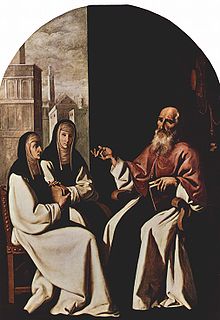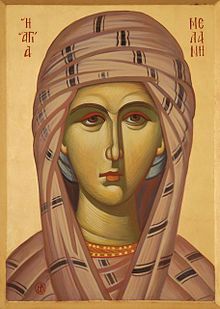- Desert Mothers
-
 Desert Mothers Saint Paula and her daughter Eustochium with their spiritual advisor Saint Jerome—painting by Francisco de Zurbarán.
Desert Mothers Saint Paula and her daughter Eustochium with their spiritual advisor Saint Jerome—painting by Francisco de Zurbarán.
The Desert Mothers were female Christian ascetics living in the desert of Egypt, Palestine, and Syria in the 4th and 5th centuries CE. They typically lived in the monastic communities that began forming during that time, though sometimes they lived as hermits. Other women from that era who influenced the early ascetic or monastic tradition while living outside the desert are also described as Desert Mothers.[1]
The Desert Fathers are much more well known because of the many early texts written by and about them. There are no writings directly attributed to the Desert Mothers—the stories about them come from the early Desert Fathers and their biographers. The Apophthegmata Patrum, or Sayings of the Desert Fathers, includes forty-seven sayings that are actually attributed to the Desert Mothers. There are several chapters dedicated to the Desert Mothers in the Lausiac History by Palladius, who mentions 2,975 women living in the desert.[2] Other sources include the various stories told over the years about the lives of saints of that era, traditionally called vitae ("life").[1][3]
Contents
Notable Desert Mothers
 Icon of Melania the Younger
Icon of Melania the Younger
The Desert Mothers were known as ammas (spiritual mothers), comparable to the Desert Fathers (abbas), due to the respect they earned as spiritual teachers and directors.[4] One of the most well known Desert Mothers was Amma Syncletica of Alexandria, who had twenty-seven sayings attributed to her in the Sayings of the Desert Fathers. Two other ammas, Theodora of Alexandria and Amma Sarah of the Desert, also had sayings in that book. Desert Mothers described in the Lausiac History include Melania the Elder, Melania the Younger, Olympias, Saint Paula and her daughter Eustochium, and several women whom the author does not name.[3]
According to written accounts, Amma Syncletica was born in 380 CE to wealthy parents in Alexandria and was well educated, including an early study of the writings of Desert Father Evagrius Ponticus. After the death of her parents, she sold everything she had and gave the money to the poor. Moving outside the city with her blind sister, she lived as a hermit among the tombs outside of Alexandria. Gradually a community of women ascetics grew up around her, who she served as their spiritual mother. Even though she was an ascetic and hermit, Syncletica taught moderation, and that asceticism was not an end in itself.[5]
Theodora of Alexandria was the amma of a monastic community of women near Alexandria. Prior to that, she had fled to the desert disguised as a man and joined a community of monks. She was sought out by many of the Desert Fathers for advice—reportedly Bishop Theophilus of Alexandria came to her for counsel.[6][7]
Sarah of the Desert's sayings indicate that she was a hermit living by a river for sixty years. Her sharp replies to some of the old men who challenged her show a distinctly strong personality.[3] According to one story, two male anchorites visited her in the desert and decided, "Let's humiliate this old woman." They said to her, "Be careful not to become conceited thinking to yourself: "Look how anchorites are coming to see me, a mere woman." She replied, "According to nature I am a woman, but not according to my thoughts."[8]
Melania the Elder, the daughter of a Roman official, became widowed at a young age and moved to Alexandria, and then to the Nitrian Desert. She met several of the Desert Fathers, following them in their travels and ministering to them using her own money. At one point she was thrown into prison for supporting them, after several of the Fathers had been banished by the officials in Palestine. She eventually founded a convent in Jerusalem which had about fifty nuns.[9]
Her granddaughter, Melania the Younger, was married at the age of thirteen and had two sons, both of whom died at a young age. When she was twenty, she and her husband Pinianus renounced the world, both founding convents and monasteries.[9]
Sayings
- Amma Sarah said, "If I prayed God that all people should approve of my conduct, I should find myself a penitent at the door of each one, but I shall rather pray that my heart may be pure toward all."[10]
- Amma Syncletica said, "In the beginning there are a great many battles and a good deal of suffering for those who are advancing towards God and afterwards, ineffable joy. It is like those who wish to light a fire; at first they are choked by the smoke and cry, and by this means obtain what they seek ... so we must also kindle the divine fire in ourselves through tears and hard work."[11]
- Amma Syncletica said, "There are many who live in the mountains and behave as if they were in the town; they are wasting their time. It is possible to be a solitary in one's mind while living in a crowd; and it is possible for those who are solitaries to live in the crowd of their own thoughts."[12]
- Amma Theodora said that neither asceticism, nor vigils, nor any kind of suffering are able to save. Only true humility can do that. There was a hermit who was able to banish the demons. And he asked them: "What makes you go away? Is it fasting?" They replied: "We do not eat or drink." "Is it vigils?" They said: "We do not sleep." "Then what power sends you away?" They replied: "Nothing can overcome us except humility alone." Amma Theodora said: "Do you see how humility is victorious over the demons?"[13]
See also
- Blaesilla
- Catherine of Alexandria
- Christian monasticism
- Demiana
- Domnina of Syria
- Eastern Christian monasticism
- John Chryssavgis
- Macrina the Elder
- Macrina the Younger
- Margaret the Virgin
- Mary of Egypt
- Menodora, Metrodora, and Nymphodora
- Saint Pelagia
- Syncletica of Alexandria
- Theoctiste of Lesbos
- Sarah of the Desert
- Melania the Younger
Notes
- ^ a b Johnston 2000, p. 373
- ^ King 1989
- ^ a b c Johnston 2000, p. 374
- ^ Earle 2007, pp. 1–2
- ^ Chryssavgis 2008, pp. 29–32
- ^ Swan 2001, p. 104
- ^ Earle 2007, p. 41
- ^ Forman 2005, p. 32
- ^ a b Palladius 1918
- ^ Swan 2001, p. 43
- ^ Swan 2001, p. 39
- ^ Chryssavgis 2008, p. 30
- ^ Chryssavgis 2008, p. 73
References
- Chryssavgis, John (2008), In the Heart of the Desert: Revised Edition: The Spirituality of the Desert Fathers and Mothers (Treasures of the World's Religions), Bloomington, Ind.: World Wisdom, pp. 29–32, ISBN 1-933316-56-X, http://books.google.com/books?id=goeFHFiL2h0C&pg=PA29
- Earle, Mary C. (2007), The Desert Mothers: Spiritual Practices from the Women of the Wilderness, Church Publishing, Inc., ISBN 9780819221568, http://books.google.com/books?id=PgWo3cOtngUC&pg=PA1
- Forman, Mary (2005), Praying with the Desert Mothers, Liturgical Press, p. 32, ISBN 9780814615225, http://books.google.com/books?id=EakvWfy6xLUC&pg=PA32
- King, Margot (1989), The Desert Mothers, Peregrina Publishing, http://www.hermitary.com/articles/mothers.html
- Johnston, William M. (2000), Encyclopedia of Monasticism, 1, Fitzroy Dearborn Publishers, pp. 373–374, ISBN 9781579580902, http://books.google.com/books?id=GfC0TDkJJNgC&pg=PA373
- Palladius (1918), The Lausiac History, Translation by W. K. L. Clarke, Macmillan (online edition by Fordham University), http://www.fordham.edu/halsall/basis/palladius-lausiac.html
- Swan, Laura (2001), The Forgotten Desert Mothers: Sayings, Lives, and Stories of Darly Christian Women, Paulist Press, pp. 39, 43, ISBN 9780809140169, http://books.google.com/books?id=goeFHFiL2h0C&pg=PA29
Further reading
- Cameron, Averil; Puttick, Elizabeth; Clarke, Bernard (1993), Desert Mothers: Women Ascetics in Early Christian Egypt, Edwin Mellen Press, http://books.google.com/books?id=S1ZqNQAACAAJ
- Ward, Benedicta (1985). "Apophthegmata Matrum". Studia Patristica (Berlin: Akademie Verlag) 16 (2): 63–66.
Categories:- Asceticism
- Christian orders
- Religious occupations
- Christian nuns
- Eastern Orthodoxy
- Eastern Catholicism
- Egyptian hermits
- Christian monasticism
- 4th-century Christian female saints
- 5th-century Christian female saints
- Christian terms
Wikimedia Foundation. 2010.
